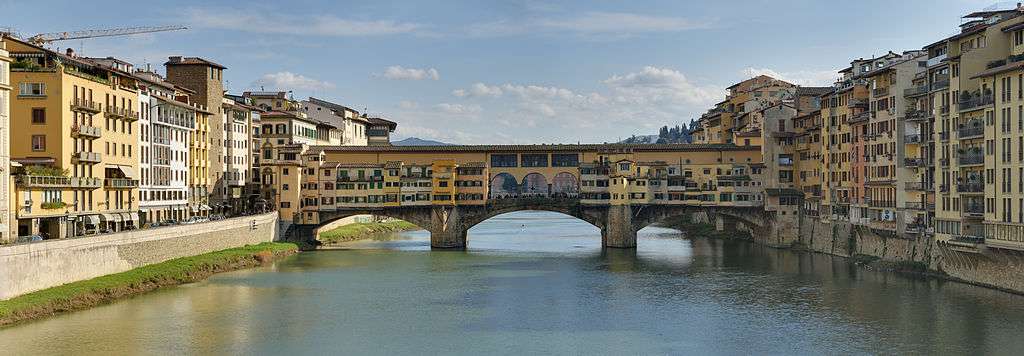Ponte Vecchio
The Ponte Vecchio ("Old Bridge", Italian pronunciation: [ˈponte ˈvɛkkjo])[1][2] is a medieval stone closed-spandrel segmental arch bridge over the Arno River, in Florence, Italy. It is noted for the shops built along it, as was once common. Butchers, tanners, and farmers initially occupied the shops; the present tenants are jewelers, art dealers, and souvenir sellers.[3] The Ponte Vecchio's two neighboring bridges are the Ponte Santa Trinita and the Ponte alle Grazie.
Ponte Vecchio | |
|---|---|
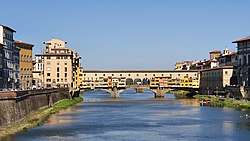 | |
| Coordinates | 43°46′4.76″N 11°15′11.49″E |
| Crosses | Arno River |
| Locale | Florence, Italy |
| Characteristics | |
| Design | closed-spandrel segmental stone arch bridge |
| Width | 32 metres (105 ft) |
| Longest span | 30 metres (98 ft) |
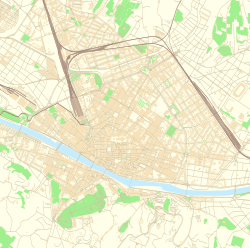 Ponte Vecchio Location in Florence 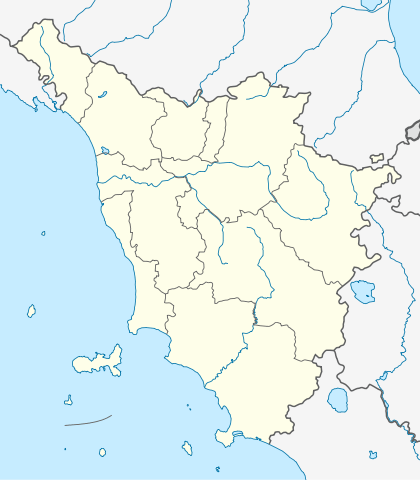 Ponte Vecchio Ponte Vecchio (Tuscany) | |
History and construction
The bridge spans the Arno at its narrowest point[4] where it is believed that a bridge was first built in Roman times,[5] when the via Cassia crossed the river at this point.[4] The Roman piers were of stone, the superstructure of wood. The bridge first appears in a document of 996[4] and was destroyed by a flood in 1117[3] and reconstructed in stone. In 1218 the Ponte alla Carraia, a wooden structure, was established nearby which led to it being referred to as "Ponte Nuovo" relative to the older (Vecchio) structure.[3] It was swept away again in 1333[5] except for two of its central piers, as noted by Giovanni Villani in his Nuova Cronica.[6] It was rebuilt in 1345.[7] Giorgio Vasari recorded the traditional view of his day that attributed its design to Taddeo Gaddi [1]— besides Giotto one of the few artistic names of the trecento still recalled two hundred years later. Modern historians present Neri di Fioravanti as a possible candidate as builder.[4] Sheltered in a little loggia at the central opening of the bridge is a weathered dedication stone, which once read Nel trentatrè dopo il mille-trecento, il ponte cadde, per diluvio dell' acque: poi dieci anni, come al Comun piacque, rifatto fu con questo adornamento.[8] The Torre dei Mannelli was built at the southeast corner of the bridge to defend it.
The bridge consists of three segmental arches: the main arch has a span of 30 meters (98 feet) the two side arches each span 27 meters (89 feet). The rise of the arches is between 3.5 and 4.4 meters (11½ to 14½ feet), and the span-to-rise ratio 5:1.[9] The shallow segmental arches, which require fewer piers than the semicircular arch traditionally used by Romans, enabled ease of access and navigation for animal-drawn carts.[3] Another notable design element is the large piazza at the center of the bridge that Leon Battista Alberti described as a prominent ornament in the city.[3]
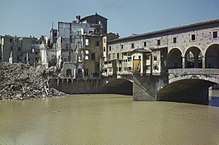
It has always hosted shops and merchants who displayed their goods on tables before their premises, after authorization by the Bargello (a sort of a lord mayor, a magistrate and a police authority). The back shops (retrobotteghe) that may be seen from upriver, were added in the seventeenth century.[4]
During World War II, the Ponte Vecchio was not destroyed by the German army during their retreat at the advance of the British 8th Army on 4 August 1944, unlike all the other bridges in Florence.[10][11] This was, according to many locals and tour guides, because of an express order by Hitler.[12][13][14] Access to the Ponte Vecchio was, however, obstructed by the destruction of the buildings at both ends of the bridge, which have since been rebuilt using a combination of original and modern designs.
Vasari's Corridor
In order to connect the Palazzo Vecchio (Florence's town hall) with the Palazzo Pitti, in 1565 Cosimo I de' Medici had Giorgio Vasari build the Vasari Corridor above it.[5] To enhance the prestige and clean up the bridge, in 1593 the Medici Grand Dukes prohibited butchers from operating and selling there in favor of gold and silver merchants.[3] A decree was made in 1595 that excluded butchers from this bridge (only goldsmiths and jewelers are allowed) that is in effect to this day.[15] The association of butchers had monopolized the shops on the bridge since 1442. A stone with an inscription from Dante (Paradiso xvi. 140-7) records the spot at the entrance to the bridge where Buondelmonte de' Buondelmonti was murdered by the Amidei clan in 1215, which began the urban fighting of the Guelfs and Ghibellines.
Benvenuto Cellini's bust
In 1900, to honor and mark the fourth century of the birth of the great Florentine sculptor and master goldsmith Benvenuto Cellini, the leading goldsmiths of the bridge commissioned the Florentine sculptor, Raffaello Romanelli, to create a bronze bust of Cellini to stand atop a fountain in the middle of the Eastern side of the bridge, where it stands to this day.[16]
Between 2005 and 2006, 5,500 padlocks, known as love locks, which were attached to the railings around the bust of Cellini, were removed by the city council. According to the council, the padlocks were aesthetically displeasing and damaged the bust and its railings. There is now a fine for attaching love locks to the bridge.[17]
Recent history
The bridge was severely damaged in the 1966 flood of the Arno.[18]
In art
- The bridge is mentioned in the aria "O mio babbino caro" by Giacomo Puccini.
- Wall mural in Grossi Florentino, executed by students of Napier Waller under supervision
See also
Notes
- Ponte Vecchio. Encyclopædia Britannica. 2007.
- "Dizionario d'ortografia e di pronunzia" (in Italian). Rai. Retrieved 2010-02-24.
- Dupré, Judith (2017). Bridges: A History of the World's Most Spectacular Spans (Google Books). New York: Hachette/Black Dog & Leventhal. ISBN 978-0-316-47380-4. Retrieved 2 March 2020.
- Touring Club Italiano, Firenze e dintorni 1964:321
- Zucconi, Guido (1995). Florence: An Architectural Guide. San Giovanni Lupatoto, Vr, Italy: Arsenale Editrice srl. ISBN 88-7743-147-4.
- Bartlett, Kenneth R. (1992). The Civilization of the Italian Renaissance. Toronto: D.C. Heath and Company. ISBN 0-669-20900-7 (Paperback). Page 40.
- Melaragno, Michele G (1998). Preliminary Design of Bridges for Architects and Engineers. Marcel Dekker. p. 3. ISBN 0-8247-0184-4.
- Translated it would read, "In the thirty-third year following thirteen hundred, the bridge fell, from a watery flood: ten years later, at the pleasure of the Commune, it was rebuilt, with this adornment". (Touring Club Italiano, Firenze e dintorni 1964:321)
- Ponte Vecchio at Structurae. Retrieved on 2007-02-16
- Encyclopædia Britannica online, 'Ponte Vecchio'.
- Brucker, Gene (1983). Renaissance Florence. University of California Press. p. 8. ISBN 0-520-04695-1.
- "Rumour has it... Hitler and the Ponte Vecchio". Time Travel Turtle. Retrieved 20 November 2012.
- "A history of the Ponte Vecchio, Florence". Holiday Velvet. Archived from the original on 19 December 2012. Retrieved 20 November 2012.
- "Florence: Walk with the Medicis over the Ponte Vecchio plebs". The Independent. London. 6 January 2008. Retrieved 20 November 2012.
- Haegen, Anne Mueller von der; Strasser, Ruth F. (2013). "Ponte Vecchio". Art & Architecture: Tuscany. Potsdam: H.F.Ullmann Publishing. p. 216. ISBN 978-3-8480-0321-1.
- "Raffaello Romanelli | Romanelli Sculpture Studio and Gallery". Galleria Romanelli. Retrieved 2019-12-03.
- "Florence tries to stamp out locks of love". Italy Mag. 1 May 2006. Archived from the original on 26 August 2012. Retrieved 17 June 2018.
- Ponte Vecchio at web site of the Kunsthistorisches Institut in Florenz
References
- Chiarugi, Andrea, Foraboschi, Paolo'Maintenance of the Ponte Vecchio historical bridge in Florence', in Extending the Lifespan of Structures, Vol. 2 (San Francisco: IABSE Symposium Report, 1995) pp. 1479–1484
- Dupré, Judith (2017). Bridges: A History of the World's Most Spectacular Spans. New York: Hachette/Black Dog & Leventhal Press. ISBN 978-0-316-47380-4
- Flanigan, Theresa, "The Ponte Vecchio and the Art of Urban Planning in Late Medieval Florence," Gesta 47 (2008): 1-15.
- Fletcher, Banister: A History of Architecture (London: The Butterworth Group, 1987, ISBN 0-408-01587-X) pp. 756–757
- Graf, Bernhard, Bridges that Changed the World (Munich, Germany: Prestel, 2002, ISBN 3-7913-2701-1) pp. 38–39
External links
| Wikimedia Commons has media related to Ponte Vecchio. |
